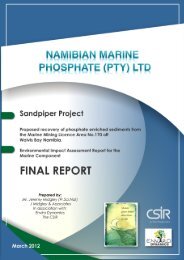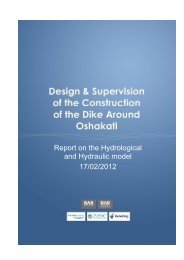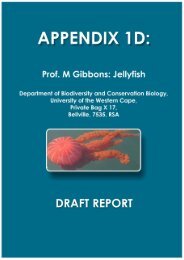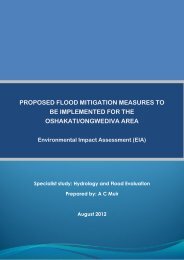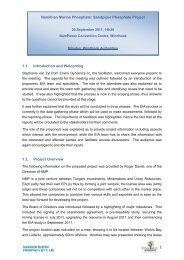Fisheries - Enviro Dynamics Namibia
Fisheries - Enviro Dynamics Namibia
Fisheries - Enviro Dynamics Namibia
You also want an ePaper? Increase the reach of your titles
YUMPU automatically turns print PDFs into web optimized ePapers that Google loves.
F I S H E R I E S , M A M M A L S A N D S E A B I R D S S P E C I A L I S T S T U D Y<br />
Bank Cormorants from Mercury, fitted with GPS trackers, targeted bearded goby Sufflogobius<br />
bibarbatus within 5 km of the coast in water depths of 30 - 40 m (Ludynia et al. 2010). The Bank<br />
Cormorant is highly unlikely to occur in ML 170 and therefore, will not be affected by the<br />
dredging operations.<br />
Cape Cormorant<br />
The Cape Cormorant Phalacrocorax capensis is considered to be Near Threatened having<br />
declined from 143 000 pairs in 1978/79 to 92 000 pairs in 1995/96 (Crawford et al. 2007b). The<br />
construction of guano platforms, providing greater secure breeding areas, is believed to have led<br />
to the increase of the population of Cape Cormorants in <strong>Namibia</strong> in the late 1970s. The<br />
subsequent decline has been attributed to a lack of sardines and anchovies, greater foraging<br />
effort and poorer food quality. Unlike the populations of the Cape Gannet, <strong>Namibia</strong> remains the<br />
stronghold of the Cape Cormorant population. In 2005/05 it supported 60.6% of the global<br />
breeding population of 94 539 pairs (Crawford et al. 2007b). Of the 57 323 pairs in <strong>Namibia</strong> in<br />
2005/06 43% were south of Walvis Bay and 57% to the north where they breed on artificial<br />
platforms designed to collect their guano.<br />
Similar to the Bank Cormorant, the Cape Cormorant is an inshore species, which is highly unlikely<br />
to occur in ML 170, and therefore, will not be affected by the dredging operations.<br />
4.1.2 Pelagic seabirds<br />
Crawford et al. (1991) reviewed the role of seabirds as consumers in the Benguela Current and<br />
western Agulhas ecosystems. Four regions were recognised: northern <strong>Namibia</strong>, southern<br />
<strong>Namibia</strong>, western South Africa and southern South Africa. The southern <strong>Namibia</strong> region<br />
corresponds to the location of ML 170 and its environs. Populations of pelagic seabirds are<br />
highest during the austral winter when Southern Ocean species, such as albatrosses, petrels,<br />
shearwaters and storm petrels, move north to temperate and subtropical regions. Some<br />
shearwaters, storm petrels and jaegers from the Northern Hemisphere are present in the austral<br />
summer but in much smaller numbers than the austral pelagic species (Appendix 1a-1). Petersen<br />
et al. 2007 and Nel (2004) have also highlighted the impact of bird mortality (albatrosses and<br />
petrels predominantly) in mostly large pelagic fishing operations (occurring mostly well offshore<br />
and beyond the MLA.<br />
None of these species is deep-diving thus the dredging operation should have no effect on<br />
them. These birds may however be attracted to the dredger's lights, particularly in foggy<br />
conditions. The potential impact of lights on seabirds was stressed by Ryan (1991). “Night<br />
strikes” due to birds being dazzled by bright lights can be a significant source of mortality of<br />
seabirds in the Tristan da Cunha rock lobster fishery. This effect was however minimised<br />
through mitigation 1 .<br />
1 Note. The lack of facilities for handling oiled seabirds at MFMR Walvis Bay / Swakopmund is noted.<br />
This applies to all marine activities in which oil spills may occur and should be the responsibility of the competent<br />
authority. This does not negate the responsibility of the mining operator to minimize the potential for oil pollution and<br />
impacts on sea birds.<br />
Final Report<br />
<strong>Namibia</strong>n Marine Phosphate (Pty) Ltd.<br />
Page 34



